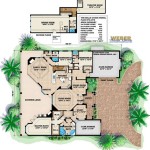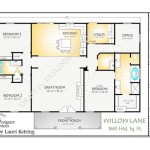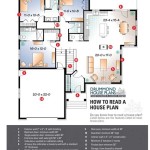New House Floor Plans are technical drawings that provide a detailed layout of a house’s interior. They are essential for both architects and contractors as they provide a roadmap for constructing the house’s structure and ensuring that all the necessary elements, such as walls, windows, doors, and utilities, are properly planned and executed.
Floor plans are used for various purposes throughout the construction process. They help to visualize the house’s layout, estimate the materials needed, and coordinate the work of different contractors. For homeowners, floor plans can be valuable tools for planning their home’s interior design and ensuring that their furniture and belongings fit comfortably within the space.
In this article, we will explore the different types of new house floor plans, their benefits, and the factors to consider when choosing one. We will also provide tips on how to read and understand floor plans so that you can make informed decisions about your home.
When choosing a new house floor plan, there are several important points to consider:
- Number of bedrooms and bathrooms
- Layout of the kitchen and living areas
- Size and shape of the lot
- Architectural style
- Energy efficiency
- Storage space
- Outdoor living space
- Future needs
By considering these factors, you can choose a floor plan that meets your current and future needs and creates a home that you love.
Number of bedrooms and bathrooms
One of the most important considerations when choosing a new house floor plan is the number of bedrooms and bathrooms. The number of bedrooms you need will depend on the size of your family and your future plans. If you have children, you will need at least one bedroom for each child. You may also want to consider having a guest bedroom for when friends or family come to visit.
- Master bedroom: The master bedroom is the largest bedroom in the house and typically includes a private bathroom and walk-in closet.
Details: The master bedroom should be large enough to accommodate a king-size bed, dresser, and nightstands. The bathroom should include a toilet, sink, bathtub, and shower. The walk-in closet should be large enough to store all of your clothes and shoes.
- Guest bedroom: The guest bedroom is typically smaller than the master bedroom and may not have a private bathroom.
Details: The guest bedroom should be large enough to accommodate a queen-size bed and dresser. It should also have a closet or wardrobe for guests to store their belongings.
- Children’s bedrooms: Children’s bedrooms should be large enough to accommodate a twin-size bed, dresser, and desk.
Details: If you have more than one child, you may want to consider having two children’s bedrooms so that each child has their own space. You may also want to consider having a Jack-and-Jill bathroom that is shared between the two bedrooms.
- Bathrooms: The number of bathrooms you need will depend on the size of your family and your lifestyle. If you have a large family, you may want to have at least two bathrooms. You may also want to consider having a half-bathroom on the first floor for guests.
When choosing the number of bedrooms and bathrooms, it is important to consider your current and future needs. If you are planning on having children, you will need to make sure that you have enough bedrooms to accommodate them. You should also consider the possibility of adding on to your house in the future if your family grows.
Layout of the kitchen and living areas
The layout of the kitchen and living areas is one of the most important considerations when choosing a new house floor plan. The kitchen is the heart of the home, and the living areas are where you will spend most of your time relaxing and entertaining guests. It is important to choose a layout that works well for your lifestyle and needs.
There are many different kitchen layouts to choose from, including U-shaped kitchens, L-shaped kitchens, and galley kitchens. The best layout for you will depend on the size and shape of your kitchen, as well as your cooking style. If you do a lot of cooking, you may want to choose a U-shaped kitchen or an L-shaped kitchen with an island. These layouts provide plenty of counter space and storage, and they allow you to move around the kitchen easily.
The living areas should be designed to be comfortable and inviting. The layout of the living areas will depend on the size and shape of your home, as well as your personal preferences. If you have a large family, you may want to choose a living room with a separate family room. This will give you more space to spread out and relax.
When choosing a layout for the kitchen and living areas, it is important to consider the flow of traffic. You want to choose a layout that allows you to move easily between the two spaces. You should also consider the location of the windows and doors. Natural light can make a big difference in the overall feel of the kitchen and living areas.
By carefully considering the layout of the kitchen and living areas, you can choose a floor plan that meets your needs and creates a home that you love.
Size and shape of the lot
The size and shape of the lot will have a significant impact on the type of house you can build. A larger lot will give you more options in terms of the size and style of your home. A smaller lot will require a more compact design.
- Lot size: The lot size is measured in square feet. The minimum lot size required for a new house will vary depending on the local zoning laws. In general, you will need at least a quarter of an acre to build a new house.
- Lot shape: The lot shape can also affect the type of house you can build. A rectangular lot is the most common and easiest to build on. A pie-shaped lot or a lot with an irregular shape may require a more creative design.
- Slope: The slope of the lot can also affect the cost of building a new house. A lot with a steep slope may require additional excavation and foundation work.
- Orientation: The orientation of the lot can also affect the design of your home. A lot that faces south will receive more sunlight than a lot that faces north. This can affect the placement of windows and doors, as well as the overall energy efficiency of your home.
It is important to carefully consider the size and shape of the lot before choosing a new house floor plan. The lot will dictate the size and style of your home, as well as the cost of construction.
Architectural style
The architectural style of your new home is a matter of personal preference. There are many different architectural styles to choose from, each with its own unique characteristics. Some of the most popular architectural styles include:
- Traditional: Traditional homes are typically symmetrical with a pitched roof and a front porch. They often have a formal dining room and living room, as well as a family room and kitchen.
- Contemporary: Contemporary homes are typically characterized by clean lines and open floor plans. They often have large windows and doors, as well as decks or patios that extend the living space outdoors.
- Craftsman: Craftsman homes are typically made of wood and stone, and they often have exposed beams and rafters. They often have a cozy, inviting feel.
- Ranch: Ranch homes are typically single-story homes with a long, low profile. They often have a large, open floor plan and a covered patio or porch.
- Cape Cod: Cape Cod homes are typically symmetrical with a pitched roof and a central chimney. They often have a front porch and a dormer window on the second floor.
When choosing an architectural style for your new home, it is important to consider your personal preferences, as well as the style of your neighborhood. You should also consider the climate in your area. For example, if you live in a cold climate, you may want to choose a home with a traditional or Craftsman style, which will provide more insulation and protection from the elements.
Once you have chosen an architectural style for your new home, you can start to narrow down your search for a floor plan. There are many different floor plans available for each architectural style. You can find floor plans online, in magazines, and in books. You can also work with an architect to create a custom floor plan that meets your specific needs.
The architectural style of your new home is an important decision. It will affect the overall look and feel of your home, as well as its value. By carefully considering your personal preferences, the style of your neighborhood, and the climate in your area, you can choose an architectural style that you will love for years to come.
In addition to the architectural styles listed above, there are many other architectural styles to choose from, including Mediterranean, Spanish, Tudor, and Victorian. When choosing an architectural style, it is important to do your research and find a style that you love. You should also consider the climate in your area and the style of your neighborhood.
Energy efficiency
Energy efficiency is an important consideration when choosing a new house floor plan. A well-designed floor plan can help to reduce your energy bills and make your home more comfortable and sustainable.
- Insulation: Insulation is one of the most important factors in determining the energy efficiency of your home. A well-insulated home will keep the heat in during the winter and the cool air in during the summer. This can help to reduce your energy bills by up to 50%.
Details: When choosing insulation, you need to consider the type of insulation, the R-value, and the thickness. The R-value is a measure of the insulation’s resistance to heat flow. The higher the R-value, the better the insulation.
- Windows and doors: Windows and doors are another important factor in determining the energy efficiency of your home. Energy-efficient windows and doors will help to keep the heat in during the winter and the cool air in during the summer. This can help to reduce your energy bills by up to 20%.
Details: When choosing windows and doors, you need to consider the type of frame, the glazing, and the energy-efficiency rating. The energy-efficiency rating is a measure of how well the window or door resists heat flow. The higher the energy-efficiency rating, the better the window or door.
- Appliances: The appliances in your home can also have a significant impact on your energy bills. Energy-efficient appliances use less energy to operate, which can help to reduce your energy bills and your carbon footprint.
Details: When choosing appliances, you need to look for the Energy Star label. The Energy Star label is a government-backed certification that indicates that the appliance meets certain energy-efficiency standards.
- Lighting: Lighting can also account for a significant portion of your energy bills. Energy-efficient lighting uses less energy to produce the same amount of light. This can help to reduce your energy bills and your carbon footprint.
Details: When choosing lighting, you need to look for LED bulbs. LED bulbs are the most energy-efficient type of lighting available.
By carefully considering the energy efficiency of your new home floor plan, you can choose a home that is comfortable, sustainable, and affordable to operate.
Storage space
Storage space is an important consideration when choosing a new house floor plan. A well-designed floor plan will include plenty of storage space to help you keep your home organized and clutter-free.
There are many different types of storage space to consider, including closets, cabinets, and shelves. Closets are a great place to store clothes, shoes, and other personal belongings. Cabinets are a good place to store dishes, cookware, and other kitchen supplies. Shelves are a versatile storage solution that can be used to store books, DVDs, and other items.
When choosing a new house floor plan, it is important to consider the amount of storage space you need. If you have a lot of belongings, you will need a floor plan with plenty of closets and cabinets. If you are short on space, you may want to consider a floor plan with built-in shelves or other space-saving storage solutions.
In addition to the amount of storage space, you should also consider the location of the storage space. You want to choose a floor plan that has storage space in convenient locations. For example, you may want to have a closet in the master bedroom, a cabinet in the kitchen, and a shelf in the living room.
By carefully considering the storage space in your new house floor plan, you can choose a home that meets your needs and helps you to stay organized.
Outdoor living space
Outdoor living space is an important consideration when choosing a new house floor plan. A well-designed outdoor living space can extend your living space outdoors and provide a place to relax, entertain guests, and enjoy the outdoors.
There are many different types of outdoor living spaces to choose from, including patios, decks, porches, and balconies. Patios are typically made of concrete or pavers and are located on the ground level. Decks are typically made of wood or composite materials and are elevated above the ground. Porches are typically covered and are attached to the house. Balconies are typically located on the second floor or higher and are accessed through a door or window.
When choosing an outdoor living space, you need to consider the size and shape of the space, as well as the location. You also need to consider how you will use the space. If you plan on entertaining guests, you may want to choose a larger space with a built-in grill or fireplace. If you are looking for a more private space to relax, you may want to choose a smaller space with a few chairs and a table.
In addition to the size, shape, and location of the outdoor living space, you also need to consider the materials used to construct the space. Concrete and pavers are durable and easy to maintain, but they can be hot in the summer. Wood and composite materials are more comfortable to walk on, but they require more maintenance. You also need to consider the cost of constructing the outdoor living space. Patios are typically the most affordable option, followed by decks, porches, and balconies.
By carefully considering the outdoor living space in your new house floor plan, you can choose a space that meets your needs and provides a place to relax, entertain guests, and enjoy the outdoors.
Future needs
When choosing a new house floor plan, it is important to consider your future needs. Your needs may change over time, so it is important to choose a floor plan that can adapt to your changing lifestyle.
- Changing family size: If you are planning on having children, you will need to choose a floor plan with enough bedrooms and bathrooms to accommodate your growing family. You may also want to consider a floor plan with a playroom or family room where your children can play and spend time together.
- Aging in place: If you are planning on staying in your home as you get older, you may want to choose a floor plan that is designed for aging in place. This type of floor plan will have features such as wider doorways, grab bars in the bathrooms, and a first-floor master suite.
- Changing lifestyle: Your lifestyle may change over time, so it is important to choose a floor plan that can adapt to your changing needs. For example, if you are planning on retiring, you may want to choose a floor plan with a home office or a workshop. If you are planning on starting a business, you may want to choose a floor plan with a separate entrance for your business.
- Resale value: When choosing a new house floor plan, it is important to consider the resale value of your home. A well-designed floor plan will be more appealing to potential buyers and will help you to get a higher price for your home when you sell it.
By carefully considering your future needs, you can choose a new house floor plan that will meet your needs for years to come.










Related Posts








